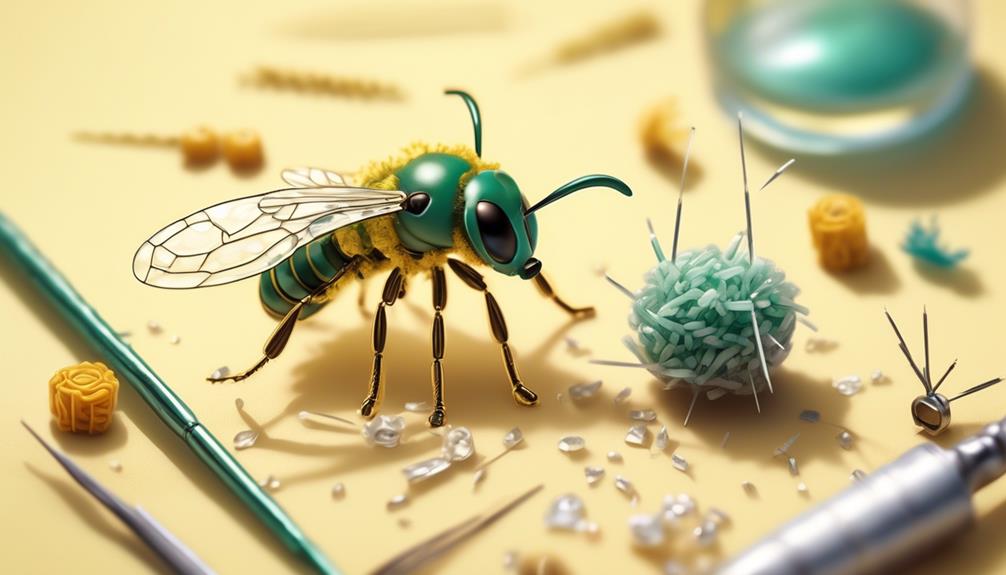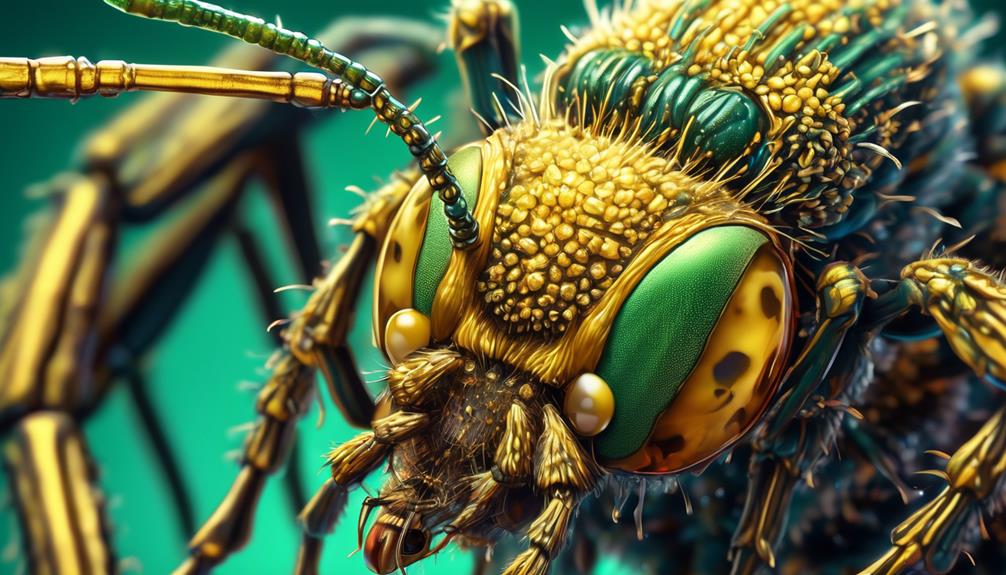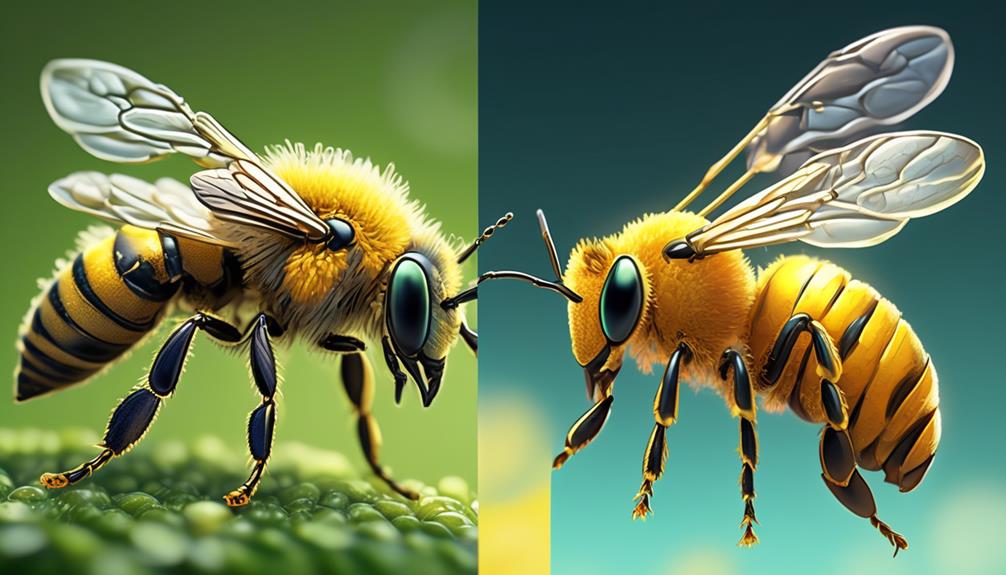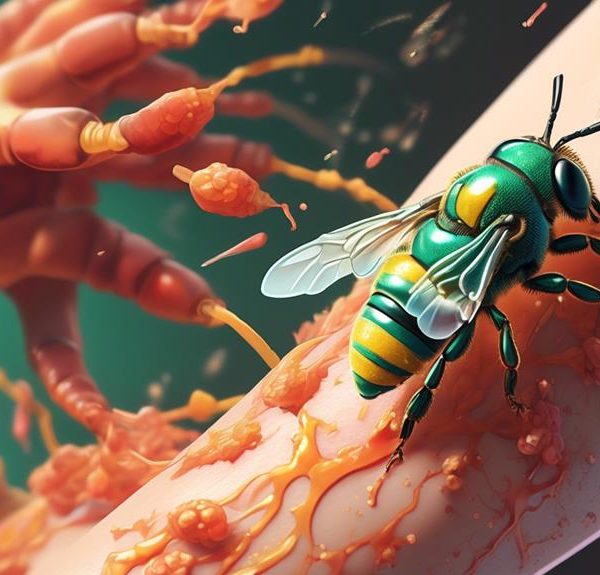Navigate the intriguing world of sweat bees, discovering the surprisingly small size of their stingers and the impact this has on their sting.

How Big Is a Sweat Bee Stinger
Imagine you're strolling in your garden on a hot summer day, when you suddenly feel a tiny prick on your arm. You look down to find a small, iridescent insect making a hasty retreat.
It's a sweat bee, and you've just been stung. While the discomfort is minimal, your curiosity about the size of the sweat bee's stinger is piqued. To put it in perspective, sweat bee stingers are generally less than 1mm – tiny in comparison to their more famous relatives like the honey bee.
But why does such a small creature possess a stinger of this size, and does its size impact the effect of its sting? The answers may surprise you as we explore further into the fascinating world of sweat bees.
Key Takeaways
- Sweat bees have a small stinger, less than 1mm in size.
- The sweat bee's stinger is a modified ovipositor, ranging in size from 0.125 to 0.5 inches.
- Despite their small size, sweat bee stings can still cause mild pain, described as a pinprick.
- Allergic reactions to sweat bee stings are rare but can be severe and require immediate medical attention.
Understanding Sweat Bee Anatomy

Often overlooked, the anatomy of a sweat bee, particularly its stinger size, plays a crucial role in its survival and interaction with the environment. You might be surprised to learn that sweat bees, despite their diminutive size, pack a potent sting. This sting isn't just for self-defense, but also crucial for the bee's reproduction process.
You might wonder, how big is a sweat bee's stinger? Well, it's not as large as you might think. In fact, it's so tiny you'd need a microscope to see it clearly. But don't let its size fool you. This tiny tool is powerful enough to penetrate human skin, leaving a mild sting.
Interestingly, sweat bee's stingers aren't just designed for defense. They're also used by female sweat bees to lay eggs. The stinger acts as an ovipositor, depositing eggs into the ground or into plant stems. This dual function is a testament to the sweat bee's adaptability.
The Size of a Sweat Bee Stinger

Now that you're familiar with the uses of a sweat bee's stinger, let's get down to the specifics and discuss its size.
A sweat bee's stinger, also known as an ovipositor, is quite small. Ranging in size from a mere 0.125 to 0.5 inches, it's almost microscopic. Here are some interesting facts about the sweat bee's stinger:
- Structure and Size
- The stinger is a modified ovipositor, an organ used by female bees for egg-laying.
- It's delicate and slender, perfect for reaching into flowers for nectar.
- Comparisons
- A sweat bee's stinger is smaller than a honeybee's, which averages around 0.6 inches.
- Some people actually compare it to the size of a sand grain.
Despite its small size, the sweat bee's stinger shouldn't be underestimated. While it's not as powerful as a honeybee's stinger, it can still cause a mild reaction. So, the next time you're out and about, remember these facts about the sweat bee's stinger. It's a tiny yet vital part of this insect's anatomy.
Comparing Bee Stingers Sizes

To truly grasp the minuscule size of a sweat bee's stinger, let's compare it to other bee stingers you might be more familiar with. A honeybee, for instance, has a stinger that's about 1.5 mm long, which seems tiny until you consider that the sweat bee's stinger is a mere 0.25 mm.
That's right, it's six times smaller than a honeybee's! An even more astonishing comparison is to the bumblebee, whose stinger can reach up to 3 mm. That's twelve times the size of the sweat bee's stinger.
But don't be fooled by these size differences. While the sweat bee's stinger is smaller, it can still pack a punch, especially if you're allergic. Its sting is often described as mildly painful, a bit like a pinprick.
Impact of Sweat Bee Stings

Despite its small size, a sweat bee's sting can have a significant impact, especially if you're allergic. The sting's effect varies between individuals, but generally, you'll experience some discomfort.
Here's the breakdown of the impact a sweat bee's sting might have:
- Immediate reaction
- *Pain:* You'll feel a sharp, burning pain at the sting site that usually subsides within an hour.
- *Swelling and Redness:* The sting site may swell and turn red. This is your body's natural defense mechanism against the sting.
- Delayed Reactions
- *Infection:* If you're not careful with the wound, there's a chance it could get infected. Always clean the sting site thoroughly.
- *Allergic Reaction:* In rare cases, if you're allergic to sweat bee stings, you could experience severe reactions, like difficulty breathing or anaphylaxis. You should seek immediate medical attention if this happens.
Ways to Prevent Sweat Bee Stings

Given the potential discomfort and risks associated with sweat bee stings, it's crucial to know how to prevent these small yet impactful insects from stinging you. Here are some effective ways to keep them at bay.
First, avoid wearing bright, floral clothing. Sweat bees are attracted to these patterns, mistaking them for actual flowers.
Next, skip the perfume. Sweat bees are drawn to strong scents, particularly floral and sweet ones. Instead, apply unscented products or those with a mild, neutral scent.
Second, keep your food and drinks covered. Sweat bees are attracted to sweet substances and can often be found hovering around sugary drinks in particular.
Third, maintain a clean environment. Sweat bees are attracted to perspiration, so regular bathing and clean-up reduces the chance of attracting these insects. Also, keep your outdoor spaces clean and free from standing water which can be a breeding ground for these bees.
Lastly, wear protective clothing. This includes long sleeves, pants, and closed-toe shoes, especially when you're in areas known for sweat bee infestation.
Conclusion
So, you've learned a sweat bee's stinger is tiny, but don't underestimate it! It's smaller than other bees, yet it can still make you feel uncomfortable.
Remember, these bees aren't out to get you. They're just defending themselves. Keep your distance and respect their space.
With the right precautions, you can avoid those pesky sweat bee stings and enjoy your time outdoors. After all, knowledge is the best defense!



